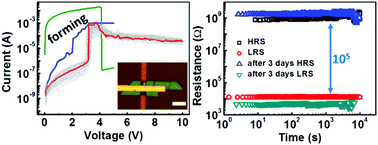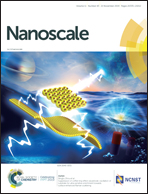A unipolar nonvolatile resistive switching behavior in a layered transition metal oxide†
Abstract
Two-dimensional layered materials have been considered as promising candidates for resistive random access memory, one of the most promising next-generation nonvolatile memories. However, due to the types of defects, most of the devices still suffer from poor environmental stability, defects inducing complexity, and uncontrollability. Here, we fabricate memory cells based on synthesized high-quality two-dimensional layered transition-metal oxide (α-MoO3) nanosheets which can be thinned to 8.68 nm (∼6 layers) and find a unipolar nonvolatile resistive switching behavior. Driven by the migration of intrinsic oxygen vacancies, the devices show a large memory window (∼105), good memory voltage stability, long-term endurance (for durations of over 3 days and 50 manual DC switching cycles) and multi-bit memory states. Furthermore, we find the devices with an excellent temperature tolerance of lower SET/RESET voltages and a larger memory window (>104 at 380 K) at higher temperatures, suggesting their potential in practical applications. Finally, all 2D memory devices are demonstrated using graphene/α-MoO3/graphene heterostructures.



 Please wait while we load your content...
Please wait while we load your content...